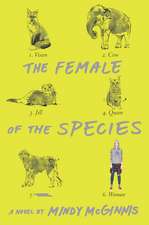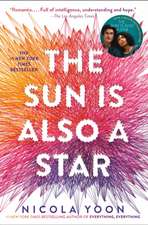The Immortal Life of Henrietta Lacks: Picador Collection
Autor Rebecca Sklooten Limba Engleză Paperback – 27 feb 2024
| Toate formatele și edițiile | Preț | Express |
|---|---|---|
| Paperback (3) | 46.84 lei 3-5 săpt. | +32.72 lei 7-13 zile |
| Pan Macmillan – 27 feb 2024 | 46.84 lei 3-5 săpt. | +32.72 lei 7-13 zile |
| BROADWAY BOOKS – 28 feb 2011 | 91.40 lei 17-23 zile | +7.93 lei 7-13 zile |
| Large Print Press – 28 feb 2011 | 111.43 lei 3-5 săpt. | |
| Hardback (1) | 172.89 lei 3-5 săpt. | +60.81 lei 7-13 zile |
| Crown Publishing Group (NY) – 31 ian 2010 | 172.89 lei 3-5 săpt. | +60.81 lei 7-13 zile |
Din seria Picador Collection
-
 Preț: 70.89 lei
Preț: 70.89 lei - 32%
 Preț: 42.83 lei
Preț: 42.83 lei - 30%
 Preț: 49.59 lei
Preț: 49.59 lei - 32%
 Preț: 43.49 lei
Preț: 43.49 lei - 33%
 Preț: 41.67 lei
Preț: 41.67 lei - 32%
 Preț: 47.67 lei
Preț: 47.67 lei - 32%
 Preț: 43.12 lei
Preț: 43.12 lei - 32%
 Preț: 47.17 lei
Preț: 47.17 lei -
 Preț: 96.52 lei
Preț: 96.52 lei - 33%
 Preț: 46.19 lei
Preț: 46.19 lei - 33%
 Preț: 42.40 lei
Preț: 42.40 lei - 30%
 Preț: 49.34 lei
Preț: 49.34 lei - 30%
 Preț: 45.48 lei
Preț: 45.48 lei - 33%
 Preț: 45.96 lei
Preț: 45.96 lei - 40%
 Preț: 43.91 lei
Preț: 43.91 lei - 32%
 Preț: 47.75 lei
Preț: 47.75 lei - 31%
 Preț: 43.52 lei
Preț: 43.52 lei - 31%
 Preț: 44.15 lei
Preț: 44.15 lei - 29%
 Preț: 50.43 lei
Preț: 50.43 lei - 33%
 Preț: 41.88 lei
Preț: 41.88 lei - 41%
 Preț: 48.86 lei
Preț: 48.86 lei - 27%
 Preț: 62.28 lei
Preț: 62.28 lei - 30%
 Preț: 49.09 lei
Preț: 49.09 lei - 32%
 Preț: 47.82 lei
Preț: 47.82 lei - 33%
 Preț: 42.20 lei
Preț: 42.20 lei - 34%
 Preț: 46.00 lei
Preț: 46.00 lei - 33%
 Preț: 46.66 lei
Preț: 46.66 lei - 32%
 Preț: 47.36 lei
Preț: 47.36 lei - 31%
 Preț: 48.04 lei
Preț: 48.04 lei - 30%
 Preț: 45.13 lei
Preț: 45.13 lei - 32%
 Preț: 46.97 lei
Preț: 46.97 lei - 21%
 Preț: 47.67 lei
Preț: 47.67 lei - 32%
 Preț: 42.78 lei
Preț: 42.78 lei - 36%
 Preț: 55.39 lei
Preț: 55.39 lei - 18%
 Preț: 51.01 lei
Preț: 51.01 lei - 37%
 Preț: 44.00 lei
Preț: 44.00 lei - 31%
 Preț: 43.52 lei
Preț: 43.52 lei - 31%
 Preț: 44.54 lei
Preț: 44.54 lei - 32%
 Preț: 42.75 lei
Preț: 42.75 lei - 32%
 Preț: 42.62 lei
Preț: 42.62 lei - 32%
 Preț: 42.90 lei
Preț: 42.90 lei - 30%
 Preț: 44.76 lei
Preț: 44.76 lei - 32%
 Preț: 42.83 lei
Preț: 42.83 lei - 31%
 Preț: 44.12 lei
Preț: 44.12 lei - 27%
 Preț: 53.24 lei
Preț: 53.24 lei - 31%
 Preț: 48.43 lei
Preț: 48.43 lei - 37%
 Preț: 43.68 lei
Preț: 43.68 lei - 34%
 Preț: 41.33 lei
Preț: 41.33 lei - 29%
 Preț: 50.37 lei
Preț: 50.37 lei
Preț: 46.84 lei
Preț vechi: 70.71 lei
-34% Nou
8.96€ • 9.28$ • 7.58£
Carte disponibilă
Livrare economică 12-26 februarie
Livrare express 29 ianuarie-04 februarie pentru 42.71 lei
Specificații
ISBN-10: 1035038617
Pagini: 464
Dimensiuni: 132 x 196 x 30 mm
Greutate: 0.32 kg
Editura: Pan Macmillan
Colecția Pan Books
Seria Picador Collection
Recenzii
New York Times Notable Book
Entertainment Weekly #1 Nonfiction Book of the Year
New Yorker Reviewers’ Favorite
American Library Association Notable Book
People Top Ten Book of the Year
Washington Post Book World Top Ten Book of the Year
Salon.com Best Book of the Year
USA Today Ten Books We Loved Reading
O, The Oprah Magazine Top Ten Book of the Year
National Public Radio Best of the Bestsellers
Boston Globe Best Nonfiction Book of the Year
Financial Times Nonfiction Favorite
Los Angeles Times Critics’ Pick
Bloomberg Top Nonfiction
New York magazine Top Ten Book of the Year
Slate.com Favorite Book of the Year
TheRoot.com Top Ten Book of the Year
Discover magazine 2010 Must-Read
Publishers Weekly Best Book of the Year
Library Journal Top Ten Book of the Year
Kirkus Reviews Best Nonfiction Book of the Year
U.S. News & World Report Top Debate-Worthy Book
Booklist Top of the List—Best Nonfiction Book
“I could not put the book down . . . The story of modern medicine and bioethics—and, indeed, race relations—is refracted beautifully, and movingly.”
—Entertainment Weekly
“Science writing is often just about ‘the facts.’ Skloot’s book, her first, is far deeper, braver, and more wonderful.” —New York Times Book Review
“The Immortal Life of Henrietta Lacks is a triumph of science writing...one of the best nonfiction books I have ever read.” —Wired.com
“A deftly crafted investigation of a social wrong committed by the medical establishment, as well as the scientific and medical miracles to which it led.”
—Washington Post
“Riveting...a tour-de-force debut.” —Chicago Sun-Times
“A real-life detective story, The Immortal Life of Henrietta Lacks probes deeply into racial and ethical issues in medicine . . . The emotional impact of Skloot’s tale is intensified by its skillfully orchestrated counterpoint between two worlds.”
—Nature
“A jaw-dropping true story . . . raises urgent questions about race and research for ‘progress’ . . . an inspiring tale for all ages.” —Essence
“This extraordinary account shows us that miracle workers, believers, and con artists populate hospitals as well as churches, and that even a science writer may find herself playing a central role in someone else’s mythology.” —The New Yorker
“Has the epic scope of Greek drama, and a corresponding inability to be easily
explained away.” —SF Weekly
“One of the great medical biographies of our time.” —The Financial Times
“Like any good scientific research, this beautifully crafted and painstakingly researched book raises nearly as many questions as it answers . . . In a time when it’s fashionable to demonize scientists, Skloot generously does not pin any sins to the lapels of the researchers. She just lets them be human . . . [and] challenges much of what we believe of ethics, tissue ownership, and humanity.” —Science
“Indelible . . . The Immortal Life of Henrietta Lacks is a heroic work of cultural and medical journalism.” —Laura Miller, Salon.com
“No dead woman has done more for the living . . . a fascinating, harrowing, necessary book.” —Hilary Mantel, The Guardian (U.K.)
“The Immortal Life of Henrietta Lacks does more than one book ought to be able to do.” —Dallas Morning News
“Above all it is a human story of redemption for a family, torn by loss, and for a writer with a vision that would not let go.” —Boston Globe
“This remarkable story of how the cervical cells of the late Henrietta Lacks, a poor black woman, enabled subsequent discoveries from the polio vaccine to in vitro fertilization is extraordinary in itself; the added portrayal of Lacks's full life makes the story come alive with her humanity and the palpable relationship between race, science, and exploitation." —Paula J. Giddings, author of Ida, A Sword Among Lions; Elizabeth A. Woodson 1922 Professor, Afro-American Studies, Smith College
“Skloot’s engaging, suspenseful book is an incredibly welcome addition for non-science wonks.” —Newsweek
“Extraordinary . . . If science has exploited Henrietta Lacks [Skloot] is determined not to. This biography ensures that she will never again be reduced to cells in a petri dish: she will always be Henrietta as well as HeLa.” —The Telegraph (U.K.)
“Brings the Lacks family alive . . . gives Henrietta Lacks another kind of immortality—this one through the discipline of good writing.” —Baltimore Sun
“A work of both heart and mind, driven by the author’s passion for the story, which is as endlessly renewable as HeLa cells.” —Los Angeles Times
“In this gripping, vibrant book, Rebecca Skloot looks beyond the scientific marvels to explore the ethical issues behind a discovery that may have saved your life.”
—Mother Jones
“More than ten years in the making, it feels like the book Ms. Skloot was born to write . . . Skloot, a young science journalist and an indefatigable researcher, writes about Henrietta Lacks and her impact on modern medicine from almost every conceivable angle and manages to make all of them fascinating . . . a searching moral inquiry into greed and blinkered lives . . . packed with memorable characters.” —Dwight Garner, New York Times, Top Ten Book of 2010
“Astonishing . . .No matter how much you may know about basic biology, you will be amazed by this book." —The Journal of Clinical Investigation
“Rebecca Skloot did her job, and she did it expertly . . . A riveting narrative that is wholly original.” —THEROOT.COM
“Moving . . .” —The Economist
“Journalist Rebecca Skloot’s history of the miraculous cells reveals deep injustices in U.S. medical research.” —TIME
“The Immortal Life of Henrietta Lacks is a fascinating look at the woman whose cultured cells—the first to grow and survive indefinitely, harvested without compensation or consent—have become essential to modern medicine.” —Vogue
“The Immortal Life of Henrietta Lacks is a remarkable feat of investigative journalism and a moving work of narrative nonfiction that reads with the vividness and urgency of fiction. It also raises sometimes uncomfortable questions with no clear-cut answers about whether people should be remunerated for their physical, genetic contributions to research and about the role of profit in science.”
—National Public Radio
“An indelible, marvelous story as powerful as those cells.” —Philadelphia Inquirer
“As much an act of justice as one of journalism.” —Seattle Times
“A stunning book . . . surely the definitive work on the subject.” —The Independent(U.K.)
“Graceful . . . I can’t think of a better way to capture the corrosive effects of ethical transgressions in medical research. It’s a heartbreaking story, beautifully rendered.” —The Lancet
“Read this . . . By letting the Lackses be people, and by putting them in the center of the history, Skloot turns just another tale about the march of progress into a complicated portrait of the interaction between science and human lives. —BOINGBOING.NET
“[A] remarkable and moving book . . . a vivid portrait of Lacks that should be as abiding as her cells.” —The Times (U.K.)
“I can’t imagine a better tale. A detective story that’s at once mythically large and painfully intimate. I highly recommend this book.” —Jad Abumrad, Radiolab
“Skloot is a terrific popularizer of medical science, guiding readers through this dense material with a light and entertaining touch.” —The Globe and Mail (Canada)
“A rare and powerful combination of race, class, gender,medicine, bioethics, and intellectual property; far more rare is the writer that can so clearly fuse those disparate threads into a personal story so rich and compelling.” —Seed
“Powerful story . . . I feel moved even to say on behalf of the thousands of anonymous black men and women who’ve been experimented on for medical purposes, thank you. Thank you for writing this important book.” —Kali-AhsetAmen, Radio Diaspora
“Skloot has written an important work of immersive nonfiction that brings not only the stories of Henrietta Lacks and HeLa once more into line, but also catharsis to a family in sore need of it.” —The Times Literary Supplement
“A masterful work of nonfiction . . . a real page turner.” —Hanna Rosin, Slate
“Skloot explores human consequences of the intersection of science and business, rescuing one of modern medicine’s inadvertent pioneers from an unmarked grave.” —US News & World Report
“Remarkably balanced and nonjudgmental . . . The Immortal Life of Henrietta Lacks will leave readers reeling, plain and simple. It has a power and resonance rarely found in any genre, and is a subject that touches each of us, whether or not we are aware of our connection to Henrietta’s gift.” —The Oregonian
“This is the perfect book. It reads like a novel but has the intellectual substance of a science textbook or a historical biography.” —The Daily Nebraskan
“Illuminates what happens when medical research is conducted within an unequal health-care system and delivers an American narrative fraught with intrigue, tragedy, triumph, pathos, and redemption.” —MS.
“A tremendous accomplishment —a tale of important science history that reads like a terrific novel.” —Kansas City Star
“Good science writing isn’t easy, but Skloot makes it appear so.” —The Wichita Eagle
“Encompasses nearly every hot-button issue currently surrounding the practice of medicine.” —Madison Capital Times
“Defies easy categorization . . . as unpredictable as any pulp mystery and as strange as any science fiction.” —Willamette Week
“An achievement . . . navigates both the technical and deeply personal sides of the HeLa story with clarity and care.” —The Portland Mercury
“[A] remarkable book.” —London Review of Books
“An essential reminder that all human cells grown in labs across the world, HeLa or otherwise, came from individuals with fears, desires, and stories to tell.”
—Chemical & Engineering News
“Blows away the notion that science writing must be the literary equivalent to Ambien.” —Chicago Tribune
“Seldom do you read a book that is science, social history, and a page turner.” —British Medical Journal
“Thrilling and original nonfiction that refuses to be shoehorned into anything as trivial as a genre. It is equal parts popular science, historical biography, and detective novel.” —Ed Yong, DISCOVER.COM
“Best book I’ve read in years.” —Brian Sullivan, Fox Business Network
“Thanks to Rebecca Skloot, we may now remember Henrietta—who she was, how she lived, how she died.” —The New Republic
“We need more writers like Rebecca Skloot.” —E.O.Wilson
Notă biografică
REBECCA SKLOOT is an award-winning science writer whose work has appeared in The New York Times Magazine; O, The Oprah Magazine; Discover; and many others. She is coeditor of The Best American Science Writing 2011 and has worked as a correspondent for NPR’s Radiolab and PBS’s Nova ScienceNOW. She was named one of five surprising leaders of 2010 by the Washington Post. Skloot's debut book, The Immortal Life of Henrietta Lacks, took more than a decade to research and write, and instantly became a New York Times bestseller. It was chosen as a best book of 2010 by more than sixty media outlets, including Entertainment Weekly, People, and the New York Times. It is being translated into more than twenty-five languages, adapted into a young reader edition, and being made into an HBO film produced by Oprah Winfrey and Alan Ball. Skloot is the founder and president of The Henrietta Lacks Foundation. She has a B.S. in biological sciences and an MFA in creative nonfiction. She has taught creative writing and science journalism at the University of Memphis, the University of Pittsburgh, and New York University. She lives in Chicago. For more information, visit her website at RebeccaSkloot.com, where you’ll find links to follow her on Twitter and Facebook.
Extras
The Woman in the Photograph
There’s a photo on my wall of a woman I’ve never met, its left corner torn and patched together with tape. She looks straight into the camera and smiles, hands on hips, dress suit neatly pressed, lips painted deep red. It’s the late 1940s and she hasn’t yet reached the age of thirty. Her light brown skin is smooth, her eyes still young and playful, oblivious to the tumor growing inside her—a tumor that would leave her five children motherless and change the future of medicine. Beneath the photo, a caption says her name is “Henrietta Lacks, Helen Lane or Helen Larson.”
No one knows who took that picture, but it’s appeared hundreds of times in magazines and science textbooks, on blogs and laboratory walls. She’s usually identified as Helen Lane, but often she has no name at all. She’s simply called HeLa, the code name given to the world’s first immortal human cells—her cells, cut from her cervix just months before she died.
Her real name is Henrietta Lacks.
I’ve spent years staring at that photo, wondering what kind of life she led, what happened to her children, and what she’d think about cells from her cervix living on forever—bought, sold, packaged, and shipped by the trillions to laboratories around the world. I’ve tried to imagine how she’d feel knowing that her cells went up in the first space missions to see what would happen to human cells in zero gravity, or that they helped with some of the most important advances in medicine: the polio vaccine, chemotherapy, cloning, gene mapping, in vitro fertilization. I’m pretty sure that she—like most of us—would be shocked to hear that there are trillions more of her cells growing in laboratories now than there ever were in her body.
There’s no way of knowing exactly how many of Henrietta’s cells are alive today. One scientist estimates that if you could pile all HeLa cells ever grown onto a scale, they’d weigh more than 50 million metric tons—an inconceivable number, given that an individual cell weighs almost nothing. Another scientist calculated that if you could lay all HeLa cells ever grown end-to-end, they’d wrap around the Earth at least three times, spanning more than 350 million feet. In her prime, Henrietta herself stood only a bit over five feet tall.
I first learned about HeLa cells and the woman behind them in 1988, thirty-seven years after her death, when I was sixteen and sitting in a community college biology class. My instructor, Donald Defler, a gnomish balding man, paced at the front of the lecture hall and flipped on an overhead projector. He pointed to two diagrams that appeared on the wall behind him. They were schematics of the cell reproduction cycle, but to me they just looked like a neon-colored mess of arrows, squares, and circles with words I didn’t understand, like “MPF Triggering a Chain Reaction of Protein Activations.”
I was a kid who’d failed freshman year at the regular public high school because she never showed up. I’d transferred to an alternative school that offered dream studies instead of biology, so I was taking Defler’s class for high-school credit, which meant that I was sitting in a college lecture hall at sixteen with words like mitosis and kinase inhibitors flying around. I was completely lost.
“Do we have to memorize everything on those diagrams?” one student yelled.
Yes, Defler said, we had to memorize the diagrams, and yes, they’d be on the test, but that didn’t matter right then. What he wanted us to understand was that cells are amazing things: There are about one hundred trillion of them in our bodies, each so small that several thousand could fit on the period at the end of this sentence. They make up all our tissues—muscle, bone, blood—which in turn make up our organs.
Under the microscope, a cell looks a lot like a fried egg: It has a white (the cytoplasm) that’s full of water and proteins to keep it fed, and a yolk (the nucleus) that holds all the genetic information that makes you you. The cytoplasm buzzes like a New York City street. It’s crammed full of molecules and vessels endlessly shuttling enzymes and sugars from one part of the cell to another, pumping water, nutrients, and oxygen in and out of the cell. All the while, little cytoplasmic factories work 24/7, cranking out sugars, fats, proteins, and energy to keep the whole thing running and feed the nucleus. The nucleus is the brains of the operation; inside every nucleus within each cell in your body, there’s an identical copy of your entire genome. That genome tells cells when to grow and divide and makes sure they do their jobs, whether that’s controlling your heartbeat or helping your brain understand the words on this page.
Defler paced the front of the classroom telling us how mitosis—the process of cell division—makes it possible for embryos to grow into babies, and for our bodies to create new cells for healing wounds or replenishing blood we’ve lost. It was beautiful, he said, like a perfectly choreographed dance.
All it takes is one small mistake anywhere in the division process for cells to start growing out of control, he told us. Just one enzyme misfiring, just one wrong protein activation, and you could have cancer. Mitosis goes haywire, which is how it spreads.
“We learned that by studying cancer cells in culture,” Defler said. He grinned and spun to face the board, where he wrote two words in enormous print: HENRIETTA LACKS.
Henrietta died in 1951 from a vicious case of cervical cancer, he told us. But before she died, a surgeon took samples of her tumor and put them in a petri dish. Scientists had been trying to keep human cells alive in culture for decades, but they all eventually died. Henrietta’s were different: they reproduced an entire generation every twenty-four hours, and they never stopped. They became the first immortal human cells ever grown in a laboratory.
“Henrietta’s cells have now been living outside her body far longer than they ever lived inside it,” Defler said. If we went to almost any cell culture lab in the world and opened its freezers, he told us, we’d probably find millions—if not billions—of Henrietta’s cells in small vials on ice.
Her cells were part of research into the genes that cause cancer and those that suppress it; they helped develop drugs for treating herpes, leukemia, influenza, hemophilia, and Parkinson’s disease; and they’ve been used to study lactose digestion, sexually transmitted diseases, appendicitis, human longevity, mosquito mating, and the negative cellular effects of working in sewers. Their chromosomes and proteins have been studied with such detail and precision that scientists know their every quirk. Like guinea pigs and mice, Henrietta’s cells have become the standard laboratory workhorse.
“HeLa cells were one of the most important things that happened to medicine in the last hundred years,” Defler said.
Then, matter-of-factly, almost as an afterthought, he said, “She was a black woman.” He erased her name in one fast swipe and blew the chalk from his hands. Class was over.
As the other students filed out of the room, I sat thinking, That’s it? That’s all we get? There has to be more to the story.
I followed Defler to his office.
“Where was she from?” I asked. “Did she know how important her cells were? Did she have any children?”
“I wish I could tell you,” he said, “but no one knows anything about her.”
After class, I ran home and threw myself onto my bed with my biology textbook. I looked up “cell culture” in the index, and there she was, a small parenthetical:
In culture, cancer cells can go on dividing indefinitely, if they have a continual supply of nutrients, and thus are said to be “immortal.” A striking example is a cell line that has been reproducing in culture since 1951. (Cells of this line are called HeLa cells because their original source was a tumor removed from a woman named Henrietta Lacks.)
That was it. I looked up HeLa in my parents’ encyclopedia, then my dictionary: No Henrietta.
As I graduated from high school and worked my way through college toward a biology degree, HeLa cells were omnipresent. I heard about them in histology, neurology, pathology; I used them in experiments on how neighboring cells communicate. But after Mr. Defler, no one mentioned Henrietta.
When I got my first computer in the mid-nineties and started using the Internet, I searched for information about her, but found only confused snippets: most sites said her name was Helen Lane; some said she died in the thirties; others said the forties, fifties, or even sixties. Some said ovarian cancer killed her, others said breast or cervical cancer.
Eventually I tracked down a few magazine articles about her from the seventies. Ebony quoted Henrietta’s husband saying, “All I remember is that she had this disease, and right after she died they called me in the office wanting to get my permission to take a sample of some kind. I decided not to let them.” Jet said the family was angry—angry that Henrietta’s cells were being sold for twenty-five dollars a vial, and angry that articles had been published about the cells without their knowledge. It said, “Pounding in the back of their heads was a gnawing feeling that science and the press had taken advantage of them.”
The articles all ran photos of Henrietta’s family: her oldest son sitting at his dining room table in Baltimore, looking at a genetics textbook. Her middle son in military uniform, smiling and holding a baby. But one picture stood out more than any other: in it, Henrietta’s daughter, Deborah Lacks, is surrounded by family, everyone smiling, arms around each other, eyes bright and excited. Except Deborah. She stands in the foreground looking alone, almost as if someone pasted her into the photo after the fact. She’s twenty-six years old and beautiful, with short brown hair and catlike eyes. But those eyes glare at the camera, hard and serious. The caption said the family had found out just a few months earlier that Henrietta’s cells were still alive, yet at that point she’d been dead for twenty-five years.
All of the stories mentioned that scientists had begun doing research on Henrietta’s children, but the Lackses didn’t seem to know what that research was for. They said they were being tested to see if they had the cancer that killed Henrietta, but according to the reporters, scientists were studying the Lacks family to learn more about Henrietta’s cells. The stories quoted her son Lawrence, who wanted to know if the immortality of his mother’s cells meant that he might live forever too. But one member of the family remained voiceless: Henrietta’s daughter, Deborah.
As I worked my way through graduate school studying writing, I became fixated on the idea of someday telling Henrietta’s story. At one point I even called directory assistance in Baltimore looking for Henrietta’s husband, David Lacks, but he wasn’t listed. I had the idea that I’d write a book that was a biography of both the cells and the woman they came from—someone’s daughter, wife, and mother.
I couldn’t have imagined it then, but that phone call would mark the beginning of a decadelong adventure through scientific laboratories, hospitals, and mental institutions, with a cast of characters that would include Nobel laureates, grocery store clerks, convicted felons, and a professional con artist. While trying to make sense of the history of cell culture and the complicated ethical debate surrounding the use of human tissues in research, I’d be accused of conspiracy and slammed into a wall both physically and metaphorically, and I’d eventually find myself on the receiving end of something that looked a lot like an exorcism. I did eventually meet Deborah, who would turn out to be one of the strongest and most resilient women I’d ever known. We’d form a deep personal bond, and slowly, without realizing it, I’d become a character in her story, and she in mine.
Deborah and I came from very different cultures: I grew up white and agnostic in the Pacific Northwest, my roots half New York Jew and half Midwestern Protestant; Deborah was a deeply religious black Christian from the South. I tended to leave the room when religion came up in conversation because it made me uncomfortable; Deborah’s family tended toward preaching, faith healings, and sometimes voodoo. She grew up in a black neighborhood that was one of the poorest and most dangerous in the country; I grew up in a safe, quiet middle-class neighborhood in a predominantly white city and went to high school with a total of two black students. I was a science journalist who referred to all things supernatural as “woo-woo stuff”; Deborah believed Henrietta’s spirit lived on in her cells, controlling the life of anyone who crossed its paths. Including me.
“How else do you explain why your science teacher knew her real name when everyone else called her Helen Lane?” Deborah would say. “She was trying to get your attention.” This thinking would apply to everything in my life: when I married while writing this book, it was because Henrietta wanted someone to take care of me while I worked. When I divorced, it was because she’d decided he was getting in the way of the book. When an editor who insisted I take the Lacks family out of the book was injured in a mysterious accident, Deborah said that’s what happens when you piss Henrietta off.
The Lackses challenged everything I thought I knew about faith, science, journalism, and race. Ultimately, this book is the result. It’s not only the story of HeLa cells and Henrietta Lacks, but of Henrietta’s family—particularly Deborah—and their lifelong struggle to make peace with the existence of those cells, and the science that made them possible.
Descriere
Her name was Henrietta Lacks, but scientists know her as HeLa. She was a poor Southern tobacco farmer who worked the same land as her slave ancestors, yet her cells—taken without her knowledge—became one of the most important tools in medicine. The first “immortal” human cells grown in culture, they are still alive today, though she has been dead for more than sixty years. If you could pile all HeLa cells ever grown onto a scale, they’d weigh more than 50 million metric tons—as much as a hundred Empire State Buildings. HeLa cells were vital for developing the polio vaccine; uncovered secrets of cancer, viruses, and the atom bomb’s effects; helped lead to important advances like in vitro fertilization, cloning, and gene mapping; and have been bought and sold by the billions.
Yet Henrietta Lacks remains virtually unknown, buried in an unmarked grave.
Now Rebecca Skloot takes us on an extraordinary journey, from the “colored” ward of Johns Hopkins Hospital in the 1950s to stark white laboratories with freezers full of HeLa cells; from Henrietta’s small, dying hometown of Clover, Virginia—a land of wooden slave quarters, faith healings, and voodoo—to East Baltimore today, where her children and grandchildren live and struggle with the legacy of her cells.
Henrietta’s family did not learn of her “immortality” until more than twenty years after her death, when scientists investigating HeLa began using her husband and children in research without informed consent. And though the cells had launched a multimillion-dollar industry that sells human biological materials, her family never saw any of the profits. As Rebecca Skloot so brilliantly shows, the story of the Lacks family—past and present—is inextricably connected to the dark history of experimentation on African Americans, the birth of bioethics, and the legal battles over whether we control the stuff we are made of.
Over the decade it took to uncover this story, Rebecca became enmeshed in the lives of the Lacks family—especially Henrietta’s daughter Deborah, who was devastated to learn about her mother’s cells. She was consumed with questions: Had scientists cloned her mother? Did it hurt her when researchers infected her cells with viruses and shot them into space? What happened to her sister, Elsie, who died in a mental institution at the age of fifteen? And if her mother was so important to medicine, why couldn’t her children afford health insurance?
Intimate in feeling, astonishing in scope, and impossible to put down, The Immortal Life of Henrietta Lacks captures the beauty and drama of scientific discovery, as well as its human consequences.


















